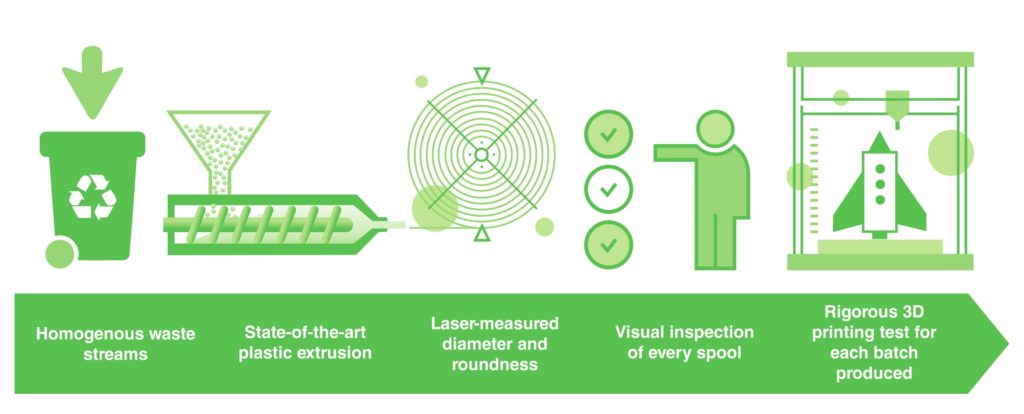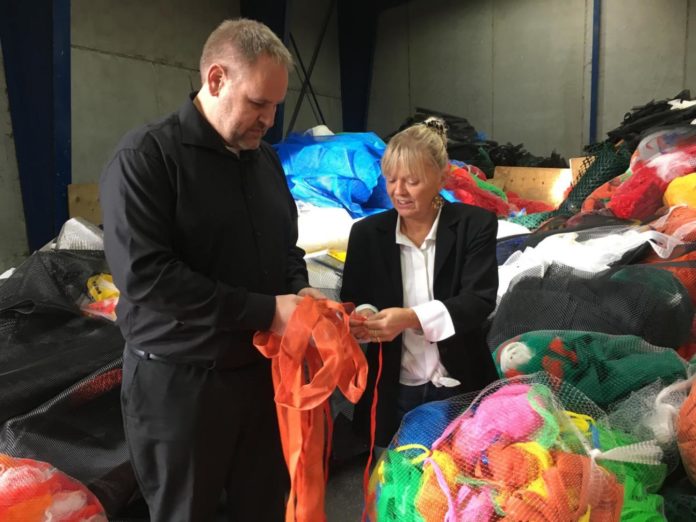A team of researchers from the University of California (Santa Barbara) recently discovered that more than 9 billion tons of plastic have been made since the 1950s, and the great majority of it has been thrown in the trash. Plastics are used everywhere, including in the 3D printing industry. Logic would have it then that, since this technology is considered as a sustainable manufacturing process, it would enable less waste, especially at the materials level, hence the increasing use of recycled materials as an alternative. The only thing is that this alternative raises several questions regarding its viability, and effective use for leveraging AM as a mass production tool or a series production tool.
What is special about recycled materials for 3D printing? What are the differences between recycled and non-recycled materials for 3D printing? Speaking of plastic materials, can all types of plastic be recycled for 3D printing? Or is there a specific type of plastic that can be recycled? Can the recycled and printed filament be recycled again? What about the quality and characteristics of these filaments compared to non-recycled filaments? Do recyclable materials present any advantages for mass production in AM?
By answering these questions, we aim to give industrials that leverage 3D printing, key insights that will help them to determine, whether or not, they can consider the use of recycled materials in their series production or mass production workflows.
Mogens Hinge will join us in this discussion. Mogens is associate professor at the Department of Engineering at Aarhus University. He’s leading the research group called Plastic and Polymer Engineering. Together with his team, they are currently involved in a research project that consists in transforming recycle plastic waste into a standardised filament product for the AM industry.
Recycled VS Non-recycled materials for 3D Printing

According to Hinge, in terms of usage, apart from the fact that the material is recycled, there is not a great difference between recycled and non-recycled materials for 3D printing. However, doubts remain regarding the properties they are supposed to deliver.
Indeed, be it grinded, melted and extruded, filaments that have been recycled and 3D printed should have the same material properties than other forms of filament. For makers, producing their own filament at home might be cost-efficient if they do it properly as they could save up to 80% on filament costs. The only thing is that while they sacrifice quality, they often end up with a lower grade of plastic, which did not always integrate the properties of the desired material.
When asked about the quality and characteristics of recycled materials for 3D printing and non-recycled materials, the Associate Professor at Aarhus University (Denmark) explains: “there is so much (maybe even all) undocumented, good and bad filament on the market today. In most cases, you only know the material type (e.g. PLA, ABS, PETG) and the thickness (1.75 or 3 mm Ø). In some few cases, there is also a printing and bed temperatures (often generic). Thus, no quality or characteristics are supplied for 3D printing filament today, why should this be different for recycled materials? It is a common mindset we face all the time that now that it is recycled then we need documentation. Most consumers have never looked at the documentation for virgin material and most cases do not have it at all. Thus, what will the knowledge of, e.g. Tg and melt-flow-index for a recycled 3D printing material be compared to [non-recycled materials]? If you ask, does it print – Yes to a very high quality, good bridging, minimal stringing, low oozing, good bed adhesion, etc.”
On the other hand, material producers or researchers that often leverage more technical expertise develop proprietary methods to produce recycled filaments that meet the desired production properties.
Reflow, for instance, is a Dutch company that develops an approach to recycle discarded plastic into a range of sustainable materials for 3D printing. The company utilizes “monomer recycling” to chemically break down plastics, removing therefore this issue of degraded performance in recycled filament.
What type of material can be recycled for 3D printing?

“In theory, all plastics can be recycled, but there are plastic types (e.g. PVC) that degrade heavily during processing and thus would be less suitable for recycling. It is clear that some types of plastic will not make sense to recycle as 3D printing filament, as not all plastics are suitable for 3D printing”, said Hinge.
Let’s take for instance the two most-commonly used filaments in the 3D printing industry: PLA & ABS.
ABS on the other hand is acknowledged for its electrical properties and its flame retardancy capability. Heat and chemical resistance make it a suitable optionfor many applications. However, studies have not yet found if such type of plastic can be recycled for 3D printing.
To avoid plastic waste, researchers and companies have been studying what kind of materials can be recycled for 3D printing. The goal is to avoid plastic waste while developing a filament that can enable many 3D printing applications.
In this vein, Hinge is currently collaborating with the largest plastic recycling company in Scandinavia, Aage Vestergaard Larsen A/S, as part of a new research and development project. The project consists in developing a standardised, documentable 3D printing filament of high and stable quality from recycled plastics.
Speaking of the situation in Denmark, Gitte Buk Larsen, business developer and marketing manager at Aage Vestergaard Larsen A/S, said three reasons explain the raison d’être of this project: “firstly, it hasn’t yet been possible to produce filament from 100% recycled plastic. Secondly, no one has cracked the code for producing filament based on a data sheet in order to ensure uniform quality. And thirdly, there are currently no filament producers in Denmark.”
It did not reveal its recycling method but Dutch company Reflow has decided to bet on PETG for recycling, a material that is gaining momentumin the industry and which combinesthe functionality of ABS and the easy printing of PLA.
Furthermore, it is also developing a filament made from polyethylene furanoate (PEF), a “bio-based” plastic. Russia-based researchers have developed and tested the material using an Ultimaker 2 3D Printer. Although it is not yet globally available, PEF integrates desirable thermal and mechanical characteristics and demonstrates its efficiency because it’s biodegradable to a higher degree than PLA.
Can the recycled and printed filament be recycled again?
In the case that the original printed filament was not a recycled material in the first place, this question would have had a twofold answer: Yes & No. Indeed, according to Trinota, a medical 3D printing company, to know if a material is recyclable, one should ask ““if there will be an end user of the recycled material?”. If there is somebody willing to buy the end product, then the material is recyclable – generally any material is recyclable, as long as there is somebody willing to pay for it.”
In the case where the recycled filament is already used, the question becomes difficult to answer. “We do not know. It is known that all plastics degrade (to different degree) during processing (recycling normally includes shredding, extrusion, and sometimes compounding). Thus, plastic recycling (when implemented) will face the challenge of 4th, 5th, 6th etc. generation material that would be somehow degraded. In some cases, unrealistic to reach 4th gen. and in other cases no problem at all. This is strongly depending on plastic type and added stabilizers (additives). This needs to be investigated further”, stated Hinge.
Any specific advantages for mass production?
From the very beginning of this article, the goal has been clearly defined: exploring if recycled 3D printing materials can be a viable option in the use of 3D printing as a mass production tool.
The topic has raised awareness on the methods used by the 3D printing community to reduce plastic waste in the environment. It also shows a crucial lack of documentation on the topic despite the little number of companies which address this issue on the market. Moreover, it shows a small palette of recycled materials available for series productions leveraging 3D Printing
Although these actions are laudable, applications of recycled materials for the 3D printing industry show a predominant use of these filaments in Do-It-Yourself projects by makers. Although the topic is of paramount importance, a number of solutions still needs to be determined to make the use of recycled materials for 3D printing a viable alternative for mass production or series production workflows.
This exclusive feature has originally been published in the 2020 March/April issue of 3D ADEPT Mag.






